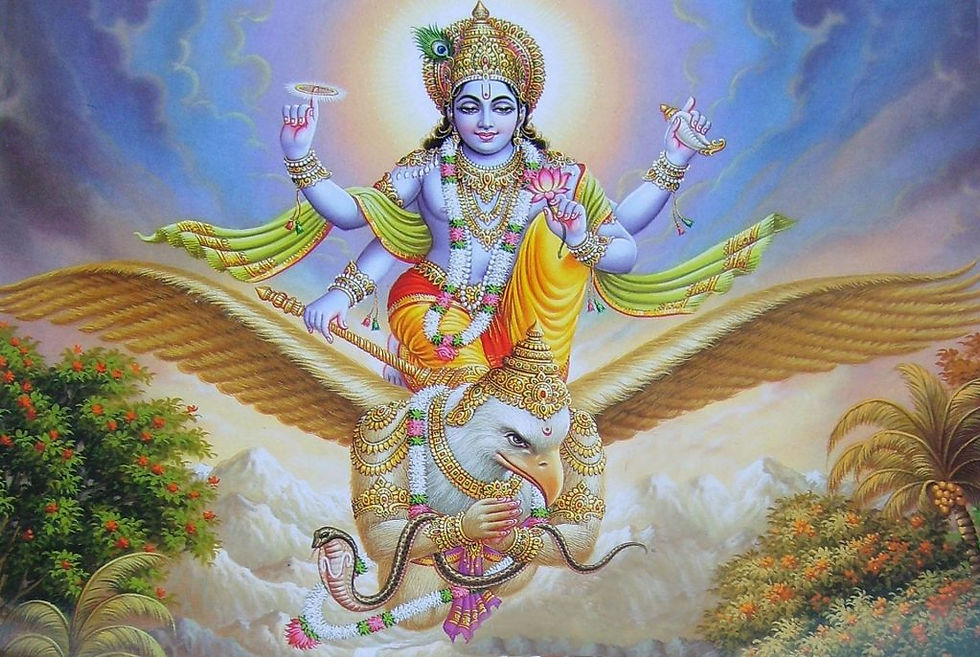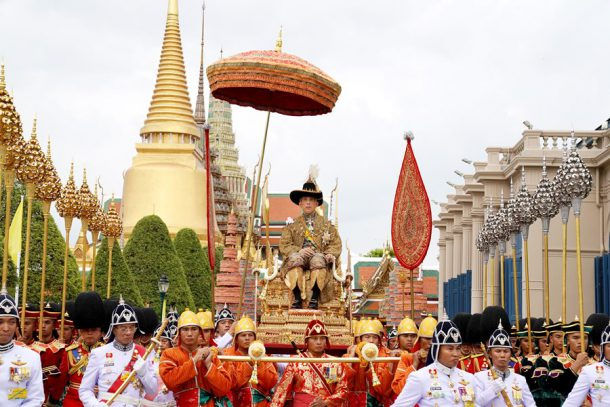Beliefs in Thailand (2)
- totoropap dokoro
- 18 มิ.ย.
- ยาว 7 นาที

I talked about the Buddhism - the main belief system in Thailand in Believes in Thailand (1). If you haven’t read yet, feel free to check it out through the link I provided. In this blog, we will explore other belief systems followed by Thai People. Aside from Buddhism, Thais also follow Hinduism and Animism.
Both of these belief system have long been woven into Thai Culture. Hinduism has traditionally influenced the upper classes, while Animism - including various forms of superstition - tends to have a stronger impact on the lower classes people or rural communities.
According to historical record, Hinduism was introduced to Thailand around the 6th century from Funan, a powerful kingdom and a major center of Hinduism at that time. However, it was between 9th to 15th centuries that Hinduism had the strongest influence on Thai Culture.
At that time the most powerful kingdom on the mainland of Southeast Asia was Angkor, also known as Yasodharapura - the capital of the Khmer Empire (located in present day Siem Reap Province, Cambodia).
The Khmer King expanded their power into what is now Thailand, especially in the southern part of the Northeast Region and the Central Region. It is believed that Lavo (present-day Lopburi) served as the Khmer capital in the Central Region, while Pimai (in present-day Nakorn Ratchasima) and Panomrung (in present day Burirum) were important centers of power in the Northeast.

The historical ruins representing the expansion of the Khmer Empire’s power at that time include Prang Samyot at Lopburi, Prasat Khao Panomrung at Burirum and Prasat Hin Phimai at Nakorn Ratchasrima.
Prasat Khao Panomrung was originally a Hindu temple. Prang Samyot also began as a Hindu temple but was later converted into a Mahayana Buddhist temple. Meanwhile Prasat Hin Phimai was built as a Mahayana Buddhist temple from the beginning.
These sites are not purely Hindu temples because during the reign of King Jayavaraman VII, Mahayana Buddhism was promoted over Hinduism, as a result, some Hindu temples were transformed into Buddhist ones by his order.

Lots of Hindu cultures flourished in Thailand during that period because the leaders who were the local people followed Hinduism like the King of Khmer Empire.
Although they later converted to Buddhism, certain aspects of Hindu cultures and principles continued to influence-especially in political thought. This influence was clearly reflected in Thai politics during 14th century in the Ayutthaya Period particular through the concept known as the Divine Kingshhip Theory. According to this theory, it believed that the King is incarnated from Vishnu who descended to Earth to relieve human suffering. Vishnu is one of the principal deities in Hinduism, is regarded as the protector of the world.

All the kings during Ayutthaya period (1350–1767 CE), the Thonburi period (1767–1782 CE), and the Rattanakosin period (1782 CE–present) adopted this concept to govern the kingdom. Even after Thailand transitioned to a Democratic system in 1932, the Divine Kingship Theory continued to influence royal rituals and ceremonies. It has still been used to reinforce the king's elevated status, despite sovereignty officially belonging to the people.
Divine Theory also gave rise to many Hindu cultural elements in Thailand such as royal Hindu ceremonies, the principle of naming kings name based on the Hindu deities, as well as influences in Thai arts and literatures. In term of the arts, much of it draws inspiration from the Indian epic Ramayana, which remain deeply rooted in Thai culture.

King Rama I adapted the Indian epic Ramayana into a Thai version known as Ramakien. The narrative emphasizes royal morality of the king and the people's loyalty to the king, reflecting the political intention behind its composition. To achieve this goal, King Rama I also expressed the Ramakien through various forms of art.
One of artworks which was chosen to express is the mural painting. Some of the mural paintings in Thai Royal Temple were created in order to support the King’s Power and Virtue. The most graceful mural painting is decorated in the cloister of the temple of Emerald Buddha. In addition, some characters like Tosakan (Ravana) or the other demons were always created the guardians to protect the temple. This story has been also adopted to create the noble performance called “Khon”. In the past, the performance will be played for the King and royal family only.
If you are a foreigner who's not yet familiar with Thai culture, you might wonder why Hindu elements can be found in Buddhist Temples.
The blending of beliefs like this has existed for a long time, mainly because of the Thai people’s cultural openness, we tend to integrate foreign influences and reshape them into something uniquely Thai. Another reason Hindu and Buddhist elements can be harmoniously combined is both religions share common roots and originated in India. As a result, many of their beliefs and principles are similar or interconnected.
Because Hinduism is a theism religion, its influence on Buddhism usually often appears in rituals and the creation of auspicious objects or symbols. When it comes to the royal ceremony, one of the most prominent examples reflecting Hindu culture is the coronation ceremony. The key purpose of this event is to elevate the king’s status from that of ordinary person to a divine ruler. As a result, the ceremonies involves many elaborate stages designed to symbolize this transformation.

If you are interested in learning more, the most recent ceremony held in 2019 is an excellent opportunity to explore this tradition in detail.
When it comes to auspicious objects or symbols associated with Hinduism, several are widely recognized among Thai people - including the holy thread, holy water, and the Shrine of Brahma.

Holy thread is the white thread made by the brahmin. It used for protecting the person who wears it from dangerous things. It’s believed that the holy thread still make people life to be smooth and safe. We also use it in the auspicious ceremonies such as wedding ceremony. This practice can also be found in Buddhism, where monks are the ones who prepare the thread and perform the ritual. This reflect the integration of Hindu and Buddhist elements within Thai religious tradition.
Like the holy thread, the purpose for using and the person who makes holy water are similar. There is the creation and use of holy water in Buddhism also.
Shrine of Brahma is built in front of the company or factory. According to Hindu Belief, Brahma is the god of creation so Thai people built it to create the good thing for the place they live. Brahma can still protect them from the dangerous thing like the ghost or evil.
When you read until this paragraph, I think you will understand about Hindu in Thailand more. Next, let me tell you about the Animism or Superstition in Thailand.
Thai people held this belief long before Buddhism and Hinduism were introduced to Southeast Asia. This reflects the traditional way of life that was deeply connected to nature and the environment. Thai people have believed that there are spirits or souls residing in natural elements such as trees, mountains and rivers. These spirits could either bless people with good fortune or cause misfortune. Many also believed that the natural phenomenon were caused by the action of these spirits.
The belief like this created the traditions and the rituals intended to honor the spirits in the nature. People at that time believed that if they performed the worship properly, the spirits would grant them blessing - such as adequate rainfall for their crops, safety and peace for their families, protection during travel (especially through forest or mountain), and success in trade or commerce.
In addition, when you travel to Thailand, you may have a chance to find the color clothes which are tied with the tree or see the shrine which look like a wood house. These shrines will be placed in front of the house and there are old man and woman inside it. You also may see the statue of woman in the posture like she is calling something. All of them tell you about the belief of Animism or Superstition in Thailand.
The tree which is tied by the clothes means to respect the angel living at that tree. Thai people will make a wish with this angel to get things they hope.

Shrine which is stood in front of the house may be called shrine of household (Spirit Shrine). Thai people built this kind of shrine for hoping the souls who stay inside the shrine will protect them from bad thing and also bless for the resident.

The statue of woman in the posture of calling something will often placed at the shop or the restaurant. (Called “Nang Kwak” in Thai language / Calling Woman in English) Thai people believe she can make a profit to them by calling the customers or a lot of moneys. Normally they will offer her by giving the red water which represents spirit.

Apart from the spirit residing in the nature or environment, Thai people gave an important to the souls of Ancestors and souls of Heroes. Many traditions and ceremonies honoring them have been passed down through generation and are still practice today. One of these examples is the status of King Rama V after he died.
After his reign, Thai people have honored King Rama V as a Heroics. He is deeply respected for his significant reforms and his dedication to the well-being of the people. Many Thais continued to pay homage to him, much like they do with Buddha Images, often making wishes or seeking blessings in his name.

Although Hinduism and Buddhism were introduced to Southeast Asia as well as Thailand around sixth century, the Animism or Superstition were still given an importance. It was integrated to Hinduism and Buddhism later. Some Thai academicians defy this integration that “the Thai Religion” .
In my opinion,
“I think this definition can tell the belief in Thailand clearly. We can’t tell directly that Thai people are Buddhist because there are lots of believes bending with Buddhism.”
If you have a chance to travel or stay in Thailand, you will understand why I say like this.
Thank you for reading until this. Hoping this blog will help you understand the way of Thai people’s life more. I will write lots of blogs to get insight Thai society, please wait to read it!






ความคิดเห็น